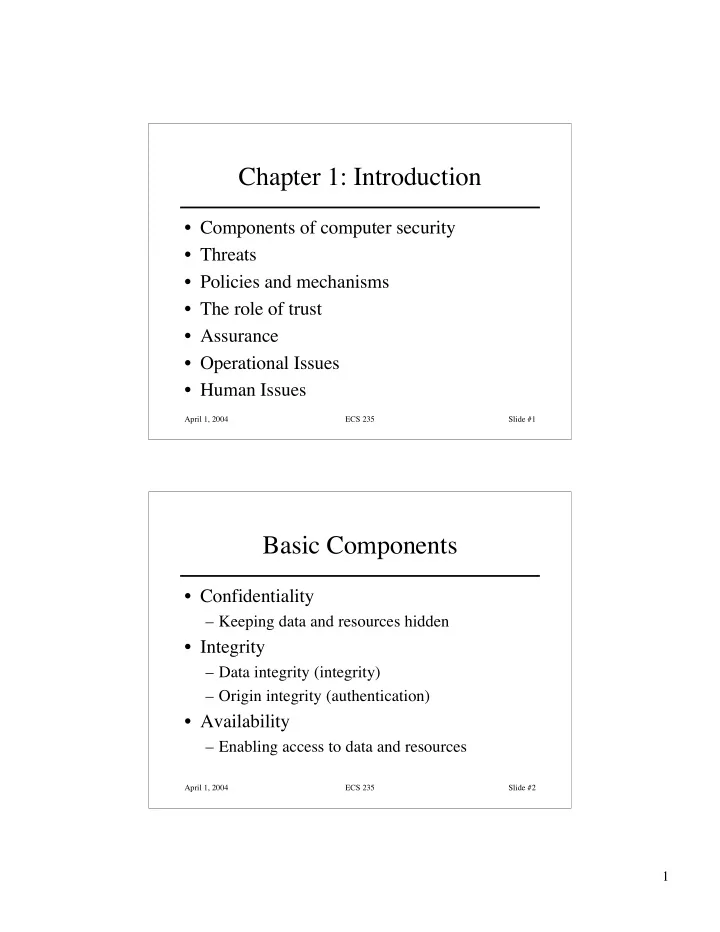

Chapter 1: Introduction • Components of computer security • Threats • Policies and mechanisms • The role of trust • Assurance • Operational Issues • Human Issues April 1, 2004 ECS 235 Slide #1 Basic Components • Confidentiality – Keeping data and resources hidden • Integrity – Data integrity (integrity) – Origin integrity (authentication) • Availability – Enabling access to data and resources April 1, 2004 ECS 235 Slide #2 1
Classes of Threats • Disclosure – Snooping • Deception – Modification, spoofing, repudiation of origin, denial of receipt • Disruption – Modification • Usurpation – Modification, spoofing, delay, denial of service April 1, 2004 ECS 235 Slide #3 Policies and Mechanisms • Policy says what is, and is not, allowed – This defines “security” for the site/system/ etc . • Mechanisms enforce policies • Composition of policies – If policies conflict, discrepancies may create security vulnerabilities April 1, 2004 ECS 235 Slide #4 2
Goals of Security • Prevention – Prevent attackers from violating security policy • Detection – Detect attackers’ violation of security policy • Recovery – Stop attack, assess and repair damage – Continue to function correctly even if attack succeeds April 1, 2004 ECS 235 Slide #5 Trust and Assumptions • Underlie all aspects of security • Policies – Unambiguously partition system states – Correctly capture security requirements • Mechanisms – Assumed to enforce policy – Support mechanisms work correctly April 1, 2004 ECS 235 Slide #6 3
Types of Mechanisms secure broad precise set of reachable states set of secure states April 1, 2004 ECS 235 Slide #7 Assurance • Specification – Requirements analysis – Statement of desired functionality • Design – How system will meet specification • Implementation – Programs/systems that carry out design April 1, 2004 ECS 235 Slide #8 4
Operational Issues • Cost-Benefit Analysis – Is it cheaper to prevent or recover? • Risk Analysis – Should we protect something? – How much should we protect this thing? • Laws and Customs – Are desired security measures illegal? – Will people do them? April 1, 2004 ECS 235 Slide #9 Human Issues • Organizational Problems – Power and responsibility – Financial benefits • People problems – Outsiders and insiders – Social engineering April 1, 2004 ECS 235 Slide #10 5
Tying Together Threats Policy Specification Design Implementation Operation April 1, 2004 ECS 235 Slide #11 Chapter 13: Design Principles • Overview • Principles – Least Privilege – Fail-Safe Defaults – Economy of Mechanism – Complete Mediation – Open Design – Separation of Privilege – Least Common Mechanism – Psychological Acceptability April 1, 2004 ECS 235 Slide #12 6
Overview • Simplicity – Less to go wrong – Fewer possible inconsistencies – Easy to understand • Restriction – Minimize access – Inhibit communication April 1, 2004 ECS 235 Slide #13 Least Privilege • A subject should be given only those privileges necessary to complete its task – Function, not identity, controls – Rights added as needed, discarded after use – Minimal protection domain April 1, 2004 ECS 235 Slide #14 7
Fail-Safe Defaults • Default action is to deny access • If action fails, system as secure as when action began April 1, 2004 ECS 235 Slide #15 8
Recommend
More recommend